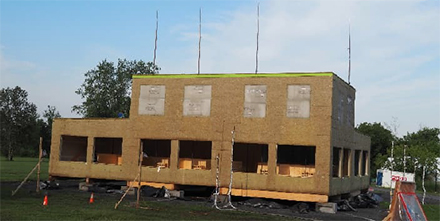The findings from Canada’s most extensive mass timber demonstration fire tests project led by the Canadian Wood Council (CWC) have been finalized in a comprehensive report titled: Large-Scale Fire Tests of a Mass Timber Building Structure for MTDFTP (Mass Timber Demonstration Fire Test Program), published by the National Research Council of Canada (NRC) on behalf of Natural Resources Canada (NRCan). Source: ReNewCanada
The Mass Timber Demonstration Fire Test Program was developed to demonstrate the performance of mass timber construction under severe fire conditions. The goal of the program is to create and disseminate valuable fire performance data to construction sector stakeholders and building and fire safety regulators to inform market acceptance of larger and taller mass timber buildings in Canada.
“We are very pleased by the report findings which solidify the position of mass timber as a safe construction material,” said Robert Jonkman vice president of Codes and Engineering at CWC.
“This scientific proof of mass timber’s exceptional structural fire performance helps address concerns about its suitability for use in larger and taller building applications.”
The report lays out the findings from a series of five separate fire research full-scale experiments conducted by the NRC as part of the program in the summer of 2022.
The experiments were conducted within a full-scale, two-storey, 334 square metre mass timber structure at NRCan’s Canadian Explosives Research Laboratory (CERL) in Ottawa.
This was the largest mass timber fire test conducted in Canada to date.
These fire tests were conducted without sprinklers and without firefighting intervention for extended hours.
The findings showed that in severe, unsprinklered fire conditions with exposed structural mass timber, the test structure remained stable and solid after enduring each of the five different fire tests of varying severity and duration, with an overall incremental total of 19 hours of fire exposure.
The findings also support the CWC’s ongoing work in codes and standards which they will use to help inform modern building codes which are evidence-based and are regularly updated to keep pace with advancements in innovative construction technologies.
As a result of this extensive project, new scientific data were gathered on the fire performance of mass timber in an open plan office, the fire performance of mass timber in residential buildings, the fire performance of mass timber during construction, and the influence of exposed mass timber on fire severity and duration. These data and the resulting knowledge outcomes can be used by stakeholders to:
- assist in the fire safety design, evaluation, and approval of alternative solutions for tall and large mass timber buildings;
- develop firefighting strategies for construction sites and finished buildings using mass timber; and
- inform code development pertinent to mass timber construction.
These comprehensive research tests examined the fire performance of both exposed and encapsulated (gypsum board protected) mass timber in highly challenging fire scenarios. These valuable data will help inform technical committees when they review code change proposals developed by the CWC seeking to enable designers to leave a certain percentage of mass timber surfaces exposed in a building of Encapsulated Mass Timber Construction (EMTC).
“This marks a significant milestone in the advancement of mass timber construction,” Mr Jonkman concluded. “Apart from the evident benefits in terms of reduced construction schedules, environmental sustainability, and fire safety that project teams are already experiencing with EMTC construction, they will now have the added advantage of offering building occupants enhanced aesthetics. Moreover, the documented positive impacts on health and well-being, attributed to the incorporation of natural materials like exposed mass timber in indoor environments, will significantly enhance the overall benefits experienced by building occupants.”
You can download the report here.






